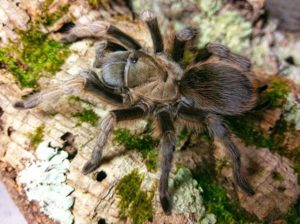Step into the world of the Carlsbad green tarantula! This unique spider, part of the tarantula family, makes its home in North America. They have interesting habits and features that make them stand out. Let’s explore more about this fascinating creature!

Aphonopelma gabeli
Like other tarantulas, they lay their eggs inside a sac made of silk threads.
Spiderlings initially stay close to their mother until they are old enough to fend for themselves.
As ambush predators, they do not construct elaborate webbing to catch prey.
Yes, Carlsbad Green Tarantulas have venom, which they use mainly to capture and eat their food.
Yes, they can. While they typically don’t seek to bite humans, they might if they feel threatened. It’s always wise to admire from a distance!
The Carlsbad green tarantula is a significant predator in desert ecosystems. Its hunting methods help control populations of various desert insects and contribute to the biological diversity of its habitat.
Natural Predators: Predators include desert-dwelling birds, mammals, and reptiles, which provide natural population control for these tarantulas.
Prey-Predator Dynamics: Their predatory lifestyle plays a key role in the food web, maintaining the balance between predator and prey species within their environment.
Relationship with Humans: Humans rarely encounter the Carlsbad green tarantula, and while it poses no significant threat, it’s best to respect their space. Their elusive nature and fascinating characteristics also make them a subject of interest for scientists and enthusiasts alike.
| Lifespan | Males: 5-15 years, Females: 20-40 years |
| Distribution | The United States, primarily Arizona, west Texas, and southern New Mexico |
| Habitat | Deserts |
| Diet | Beetles, cockroaches, crickets, grasshoppers, and moths |
In conclusion, the Carlsbad green tarantula is an essential part of North America’s desert biota, offering insights into the adaptation and survival of species in extreme environments.
Image Source: scontent.fccu20-1.fna.fbcdn.net, net-bug.net
Step into the world of the Carlsbad green tarantula! This unique spider, part of the tarantula family, makes its home in North America. They have interesting habits and features that make them stand out. Let’s explore more about this fascinating creature!

Aphonopelma gabeli
Like other tarantulas, they lay their eggs inside a sac made of silk threads.
Spiderlings initially stay close to their mother until they are old enough to fend for themselves.
As ambush predators, they do not construct elaborate webbing to catch prey.
Yes, Carlsbad Green Tarantulas have venom, which they use mainly to capture and eat their food.
Yes, they can. While they typically don’t seek to bite humans, they might if they feel threatened. It’s always wise to admire from a distance!
The Carlsbad green tarantula is a significant predator in desert ecosystems. Its hunting methods help control populations of various desert insects and contribute to the biological diversity of its habitat.
Natural Predators: Predators include desert-dwelling birds, mammals, and reptiles, which provide natural population control for these tarantulas.
Prey-Predator Dynamics: Their predatory lifestyle plays a key role in the food web, maintaining the balance between predator and prey species within their environment.
Relationship with Humans: Humans rarely encounter the Carlsbad green tarantula, and while it poses no significant threat, it’s best to respect their space. Their elusive nature and fascinating characteristics also make them a subject of interest for scientists and enthusiasts alike.
| Lifespan | Males: 5-15 years, Females: 20-40 years |
| Distribution | The United States, primarily Arizona, west Texas, and southern New Mexico |
| Habitat | Deserts |
| Diet | Beetles, cockroaches, crickets, grasshoppers, and moths |
In conclusion, the Carlsbad green tarantula is an essential part of North America’s desert biota, offering insights into the adaptation and survival of species in extreme environments.
Image Source: scontent.fccu20-1.fna.fbcdn.net, net-bug.net